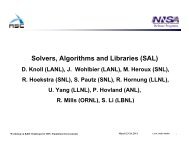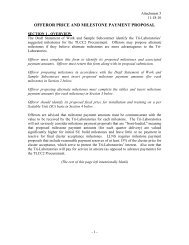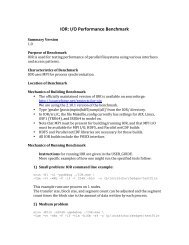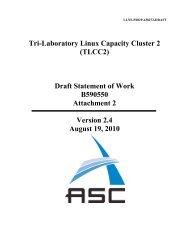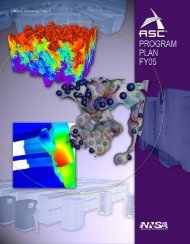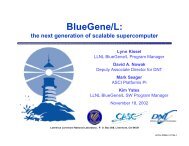Direct Numerical Simulation of Rayleigh-Taylor ... - ASC at Livermore
Direct Numerical Simulation of Rayleigh-Taylor ... - ASC at Livermore
Direct Numerical Simulation of Rayleigh-Taylor ... - ASC at Livermore
- No tags were found...
You also want an ePaper? Increase the reach of your titles
YUMPU automatically turns print PDFs into web optimized ePapers that Google loves.
<strong>Direct</strong> <strong>Numerical</strong> <strong>Simul<strong>at</strong>ion</strong> <strong>of</strong><strong>Rayleigh</strong>-<strong>Taylor</strong> InstabilityBill Cabot,Andy Cook&Paul MillerThis work was performed under the auspices <strong>of</strong> the US Department <strong>of</strong> Energy by the University <strong>of</strong> California,Lawrence <strong>Livermore</strong> N<strong>at</strong>ional Labor<strong>at</strong>ory under Contract No. W-7405-ENG48.UCRL-PRES-222608CS and Viz Support: Mike Welcome (LBL), Brian Miller,Peter Williams, Hank ChildsIWPCTM10, Paris17–21 July 2006WC-IWPCTM10
<strong>Rayleigh</strong>-<strong>Taylor</strong> instability is an unsettled issue.• Does the flow forget its initial conditions?• Is the flow self-similar?• Wh<strong>at</strong> is alpha?• How does mixing influence the growth r<strong>at</strong>e?• When does the flow become fully turbulent?• Wh<strong>at</strong> is the Reynolds number dependence?• How should subgrid-scale models beinitialized?Results from high-resolution numerical simul<strong>at</strong>ions can beused to elucid<strong>at</strong>e these issues and guide modeling.WC-IWPCTM10-2
The Navier-Stokes equ<strong>at</strong>ions have been aroundfor 185 years…∂ρ∂t + u j∂ρ= ρ ∂∂x j∂x j⎛⎜⎝D ∂ρ ⎞ρ ∂x⎟ =−ρ ∂u j,j ⎠ ∂x j∂ρu i∂t+ ∂ρu iu j∂x j=− ∂p∂x j+ ∂τ ij∂x j+ ρg i, g i= 0,0,−g ( )⎡ ⎛ ∂uτ ij= ρν i+ ∂u j⎢ ⎜⎣ ⎢ ⎝ ∂x j∂x i⎞⎟ − 2 ⎠ 3 δ ij∂u k∂x k⎤⎥⎥ ⎦…nevertheless, fluid mechanics is not a dry subject.WC-IWPCTM10-3
The governing equ<strong>at</strong>ions are solved withhigh-resolution numerical methods.‣ 10 th -order compact/Padé sp<strong>at</strong>ial deriv<strong>at</strong>ives‣ 3 rd -order predictor-corrector timestepping‣ <strong>Direct</strong> Fourier/Padé Poisson solver‣ 8 th -order dealiasing filter‣ Vertically expandinggrid is m<strong>at</strong>ched to apotential-flow solutionin the far field.The Crab Nebula is RT unstable.WC-IWPCTM10-4
Paris is the birthplace <strong>of</strong> the Navier-Stokesequ<strong>at</strong>ions as well as some key solution methods.Claude-Louis NavierGeorge StokesSiméon-Denis PoissonWho’snotFrench?Joseph FourierHenri PadéWC-IWPCTM10-5
Setup for <strong>Rayleigh</strong>-<strong>Taylor</strong> DNS:‣ 3:1 density r<strong>at</strong>io (Atwood number = 0.5)‣ Schmidt number = ν/D = 1‣ Grid spacing Δ ≈ η (Kolmogorov scale)‣ 3072 x 3072 x 3072 grid points‣ Error function for diffuse initial interface (5 grid pointsthick) with horizontally perturbed position‣ Periodic side boundaries‣ Potential-flow vertical boundaries <strong>at</strong> early times‣ Free-slip walls <strong>at</strong> top and bottom boundariesViscous and diffusion scales are resolved.WC-IWPCTM10-6
<strong>Direct</strong> <strong>Numerical</strong> <strong>Simul<strong>at</strong>ion</strong> serves as alow-Re “numerical experiment”• DNS resolves all relevant scales in turbulentflow (inertial, dissip<strong>at</strong>ion, and diffusion);there are no model approxim<strong>at</strong>ions.• Turbulence is inherently three-dimensional.• DNS is limited to low to moder<strong>at</strong>e Reynoldsnumbers, constrained by computer resources.• To reach a fully turbulent st<strong>at</strong>e (e.g., mixing transition), the outerscaleReynolds number must exceed Re > 10 4 (microscale Re λ> 10 2 ).• The range <strong>of</strong> scales (∝ number <strong>of</strong> grid points Ν) in any direction isΛ/η ∼ Re 3/4 ; hence the cost <strong>of</strong> DNS ∼ Ν 4 ∼ Re 3 (assuming perfectparallel scaling).• DNS needs large resources to reach higher Re.BG/L is the fastest computer in the world.WC-IWPCTM10-7
There is not much pure heavy fluid in the spikes.WC-IWPCTM10-8
There is not much pure light fluid in the bubbles.WC-IWPCTM10-9
Gravity and initial perturb<strong>at</strong>ions setcharacteristic length and time scales.Dominant wavelength:l = 2π∞∫0∞∫0E(k)kdkE(k)dk, l 0= l(t = 0)τ = l 1/2⎛ ⎞0Corresponding timescale: ⎜ ⎟ A = ρ 2− ρ 1,=1/2⎝ Ag⎠ρ 2+ ρ 1Initial spectrum peaked <strong>at</strong> mode 96.WC-IWPCTM10-10
Outer-scale Reynolds number reaches 32,000.Re=H H&/ vH is based on the 1%concentr<strong>at</strong>ionthreshold.Previous DNS <strong>at</strong>512 x 512 x 2040ended here.Re ~ 10 4 (Re λ~ 10 2 )marks the beginning<strong>of</strong> the turbulentregime and theform<strong>at</strong>ion <strong>of</strong> aninertial range in theenergy spectrum.Re crosses 10,000 around t/τ = 19.WC-IWPCTM10-11
Spectra develop scale separ<strong>at</strong>ion andinertial ranges <strong>at</strong> l<strong>at</strong>e time.Separ<strong>at</strong>ion > 10 for t/τ > 19. Kolmogorov spectrum for w.WC-IWPCTM10-12
Peak <strong>of</strong> energy spectrum follows a k -2 trajectory once theflow becomes self-similar. (see Olivier Poujade’s talk)WC-IWPCTM10-13
Growth and mixing are characterized in terms<strong>of</strong> a product function X p .Heavy-fluid mole fraction:X = ρ − ρ 1ρ 2− ρ 1X st=12Product (mixed fluid):X p( X) ={X / Xstif X ≤ Xst(1 − X ) /(1 − Xst) if X > XstProduct thickness:∞∫h = X p ( X )dz−∞Ξ=Mixedness:∞∫ X p−∞∞X p∫−∞( X) dz( X )dzIntegral measure <strong>of</strong> mix height is insensitiveto st<strong>at</strong>istical fluctu<strong>at</strong>ions.WC-IWPCTM10-14
In the self-similar regime, (dh/dt) 2 = 4αAgh(Ristorcelli & Clark, JFM 2004 and Jacobs & Dalziel, JFM 2005).• h orel<strong>at</strong>es to thespectrum <strong>of</strong> initialperturb<strong>at</strong>ions.• The linear term nevercompletely goesaway.• Using h/Agt 2 , largersimul<strong>at</strong>ions, run tol<strong>at</strong>er times, givesmaller α.• There is a slight butsteady increase forRe>10,000.h = αAgt 2 + 2(αAgh o ) 1/2 t + h oWC-IWPCTM10-15
Many models assume a constant r<strong>at</strong>io <strong>of</strong> kineticenergy to released potential energy.Potential energy δPis converted tokinetic energy K,which cascadesdown to smallscales where it isremoved byhe<strong>at</strong> dissip<strong>at</strong>ion Ψ.Alpha Group derivedK z/δP = 12αK/δP rises steadily for Re > 10,000.WC-IWPCTM10-16
The mixing r<strong>at</strong>e lags the entrainment r<strong>at</strong>e whenthe flow enters the turbulent regime.Ξ=∞∫−∞∞∫−∞X pX p( X) dz( X )dz1 homogenized0 segreg<strong>at</strong>edEver bigger blobs have to be broken down to ever finer scales.WC-IWPCTM10-17
Surface area exhibits weak Re dependence forRe>10,000.Area <strong>of</strong> equimolar surface scales with <strong>Taylor</strong> microscale.WC-IWPCTM10-18
Self-similarity gives: λ∼h 1/4 ∼t 1/2 , η∼h -1/8 ∼t -1/4(Ristorcelli & Clark, JFM 2004).<strong>Taylor</strong> microscales (λ i )stay anisotropic.Kolmogorov microscales(η i ) become isotropic byl<strong>at</strong>e time.DNS confirms moment similarity predictions except for λ z .WC-IWPCTM10-19
Enstrophy becomes isotropic near midplaneonly <strong>at</strong> very l<strong>at</strong>e time.isotropicanisotropicFlow near bubble and spike fronts is always highly anisotropic.WC-IWPCTM10-20
Similar trends were observed in a previous1152 3 LES (Cook, Cabot & Miller, JFM 2004).A = 0.53072 3 DNS1152 3 LESLES results suggestth<strong>at</strong> some quantitiesmay asymptote <strong>at</strong>l<strong>at</strong>er times.WC-IWPCTM10-21
Shallower slope <strong>of</strong> density spectrum isobserved in both DNS and LES.3072 3 DNS, 1152 3 LESWC-IWPCTM10-22
DNS <strong>of</strong> R-T instability <strong>at</strong> Re up to 32,000yields some surprises.• α cannot be determined by plotting h vs. Agt 2 .• Kinetic/Potential energy r<strong>at</strong>io keeps rising.• <strong>Taylor</strong> microscales are always anisotropic.• Kolmogorov scales and enstrophy eventually become isotropic.• Flow is weakly Reynolds number dependent for Re>10,000.• How should growth and mixing curves be extrapol<strong>at</strong>ed to veryhigh Reynolds number regimes?Extremely large simul<strong>at</strong>ions are requiredto escape initial, boundary, and low-Re effectsand obtain good st<strong>at</strong>istical samples.WC-IWPCTM10-23





